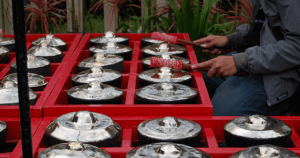Sudip Bose at The American Scholar:
 During a six-month period in 1889, nearly 900,000 people descended upon the sprawling Universal Exposition in Paris, the fourth world’s fair to be held in the city, this one constructed in the shadows of the new Eiffel Tower. For the average Parisian strolling down the Esplanade des Invalides, the sight of a Tunisian palace, an Algerian bazaar, or a Cambodian pagoda would have meant pure enchantment, and nobody was more enchanted than Claude Debussy. Inside a replica of a Javanese village, the 26-year-old composer encountered the ensemble of bronze metallophones, gongs, and other instruments known as a gamelan, the musicians in the pavilion joined by a male singer and four young female dancers. For an artist recoiling from the rigid orthodoxy of the conservatory, the music’s bright, sensuous timbres, its feeling of spaciousness, and its vaguely pentatonic scales offered Debussy a path toward something new, even if he struggled to make sense of what he heard in the context of western harmony and counterpoint.
During a six-month period in 1889, nearly 900,000 people descended upon the sprawling Universal Exposition in Paris, the fourth world’s fair to be held in the city, this one constructed in the shadows of the new Eiffel Tower. For the average Parisian strolling down the Esplanade des Invalides, the sight of a Tunisian palace, an Algerian bazaar, or a Cambodian pagoda would have meant pure enchantment, and nobody was more enchanted than Claude Debussy. Inside a replica of a Javanese village, the 26-year-old composer encountered the ensemble of bronze metallophones, gongs, and other instruments known as a gamelan, the musicians in the pavilion joined by a male singer and four young female dancers. For an artist recoiling from the rigid orthodoxy of the conservatory, the music’s bright, sensuous timbres, its feeling of spaciousness, and its vaguely pentatonic scales offered Debussy a path toward something new, even if he struggled to make sense of what he heard in the context of western harmony and counterpoint.
more here.
